5 DEFENSIVE Special Situations To Consider Down The Stretch
Your base offense and defense are in. Your players know your out of bounds plays. You've worked on change of pace defenses. In other words, the foundation has been laid and you are now finetuning those things.
As you get into the back half of your season, you must navigate a fine line. On the one hand, you have to keep your players engaged. Monotonously doing the same thing over and over again can lead to stagnation and boredom.
On the other hand, you must fight the urge to always be adding some new play. This can overwhelm your players and prevent you from ever getting good at anything.
The Importance of Special Situations
One area that is worth looking at is special situations. Every year, you will coach at least a handful of games that come down to the last few minutes. How your players handle those situations will go a long way towards determining the quality of your season. And how your players handle them will be largely determined by how you handle them.
What are Special Situations
Special situations is a term used to describe parts of a basketball game that require individualized attention and consideration, especially at the end of close games.
On offense (which will be covered shortly in another article), special situations could include things like last second plays from various situations (baseline out of bounds, sideline out of bounds, full court plays), or missing a free throw on purpose and attempting to offensive rebound the miss.
Most content about special situations in basketball addresses offense. However, half the game is defense.
This article will give you 5 defensive special situations to consider putting in your arsenal for the stretch run.

Disclaimer - You MUST Practice These Special Situations
These situations MUST be practiced. As a young coach, I made the mistake of trying to draw up plays or implement defensive strategies that we had never practiced on the board during late game timeouts. I can tell you that very rarely were successful.
When you factor in the pressure of the situation, players will be much more successful doing something they've practiced.
Practicing special situations is a great way to lessen game time stress. While practice will never be the same as games, it gives players' confidence to know they've worked on these situations previously.
This is also a great way to keep practice fresh later in the year. Players enjoy practicing these situations as they are mentally stimulating and make practice competitive.
I would suggest setting aside 20 minutes 1-2x a week throughout January and February to practice some of these scenarios.
5 Defensive Special Situations to Consider
1 - Sideline out of bounds double team
Here's the scenario: you are down 2 and your opponent has the ball sideline out of bounds with less than :10 remaining. You can all out deny and then immediately foul. You can have the inbounder follow the first pass and trap.
Those are both good options. But let's consider one that's a little bit more outside the box. In many ways, a sideline out of bounds is similar to a dead dribble. The inbounder cannot move or dribble. They are pinned to the sideline in what would be a great trap spot if they were on the floor.
Take advantage of that by trapping the inbounder. Take your two tallest and most active players (x4 and x5. Have them trap the inbounder and make the inbounds pass as hard as possible. But three of your quickest players (x1, x2, x3) in a triangle zone to cover the four potential offensive receivers.
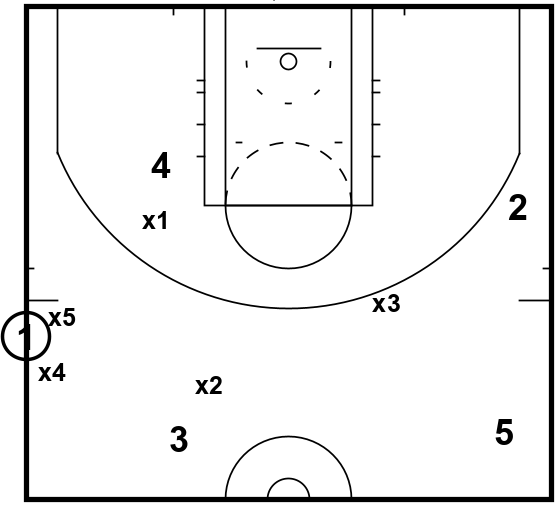
These three defenders should be reading the eyes and shoulder of the inbounder and reacting accordingly. The goal of the two on ball trapping defenders is to deflect the pass or generate a 5 count. The goal of the three defenders covering the court is to steal the inbounds.
If you get a steal, great! Go score. If not, you can try for a quick trap with the two closest defenders or can immediately foul.
This strategy is unique and can cause panic for the inbounder. It also takes away the effectiveness of the screens the offense might plan to set, since you have three zoned up against their four.
2 - Baseline out of bounds trap - 1-3-1 Trap
Here's the scenario. You are winning by one possession or the game is tied. Final minute of the game. Your opponent is inbounding on the baseline under your basket. They call a timeout to set up their best baseline out of bounds play.
You could try an all out deny to make the entry hard. You could play 2-3. Either has its merits. However, a good team and coach will have plays for both of those scenarios.
At the end of a close game, consider blowing up your opponent's play. Force them to MAKE plays, not RUN plays. I love this philosophy all the time, but it's especially effective at the end of the game when stress rises.
To spring this trap, you are going to run a version of a 1-3-1 versus their baseline out of bounds.
You will position your 5 player (x5) on the ball side block. They are responsible for that area, preventing direct passes.
Put a longer, athletic forward (x4) on the ball. Their job is to make the inbounds pass hard and to force the ball to the same side corner.
Put another longer player on the ballside wing (x3). They will face the ball and invite the pass to the ball side corner. It is crucial that they not deny this pass. This is where you want the ball to go!
Put a guard (x1) who is quick and reads well on the ballside elbow. They are responsible for any passes above the free throw line. They need to anticipate and be aggressive and are looking to steal long passes.
Finally, put your other defender (x2) on the weakside block. If you have to hide a weaker defender this is the spot. This player is responsible for the backside block to corner. They need to deny those passes and attempt to steal any pass to those areas.

One the ball is inbounded to the corner, x4 and x3 will immediately trap.
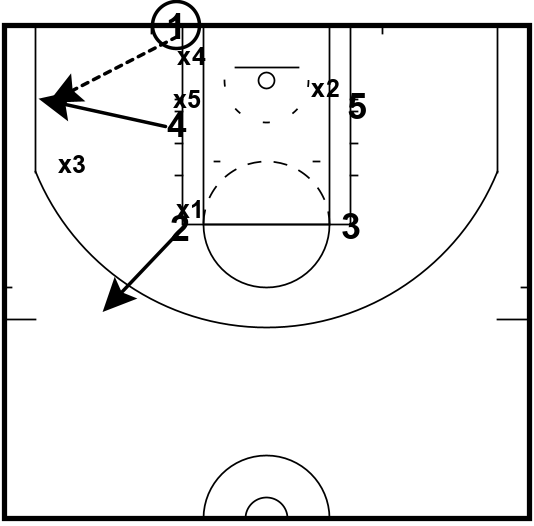
x5 has to front any player on the ballside block.
x1 denies the reversal pass.
x2 sprints to the ballside elbow to take away a middle pass. This leaves only the deep diagonal pass unguarded, which a good trap should negate.
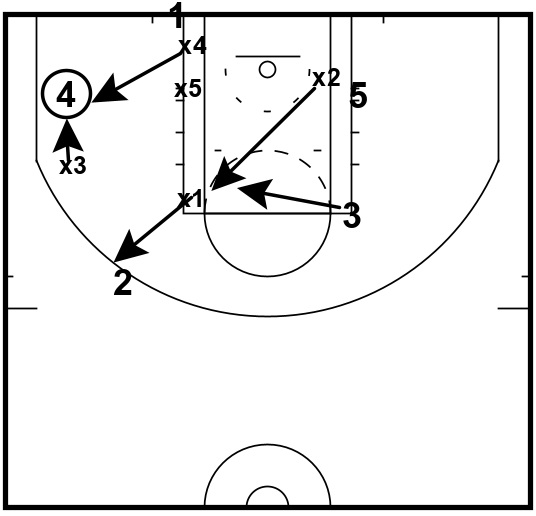
I've used this tactic numerous times to great success. It has led to steals and easy baskets. Even when we don't get a steal, it serves the purpose of preventing your opponent from running their play, a worthy goal late in the game.

3 - Trap the Jump Ball
A jump ball is a special situation. Recently, there has been attention given to some creative actions teams are running after winning the jump ball. Unfortunately, some of us don't have a player who's good at winning the jump ball. If that's you, how can you turn the tables on your opponent? Consider immediately trapping the jump ball.
You might wonder if it's worth devoting practice time to something that happens once a game. It is. First, even if it only happens one time, you can use this tactic to generate momentum at the start of the game. A quick turnover and basket is a great way to begin the game.
Second, it might happen twice. In my career, I've coached an average of one overtime game a season. Some years, we've had as many as three overtime games. Those are situations where a second jump ball will occur.
In overtime, every possession is critical. I know from experience how painful it is to lose the jump ball, have your opponent methodically run offense and score. The pressure immediately shifts to your team. Trapping the jump ball can flip the script.
You'll be shocked how often this works. What do most players do when they tip the ball back? The other players begin jogging down to the offensive spots, leaving the player with the ball exposed.
To do this successfully, you need to align your players so that any lost tip goes backward (away from your opponent's hoop). As shown below, the safest tip for 5 is back to 1.

Once the ball goes to 1, the two closest defenders (x3 and x4) will trap. x1 and x2 should come up to play the passing lanes, while x5 drops to be a safety should the trap be beat.
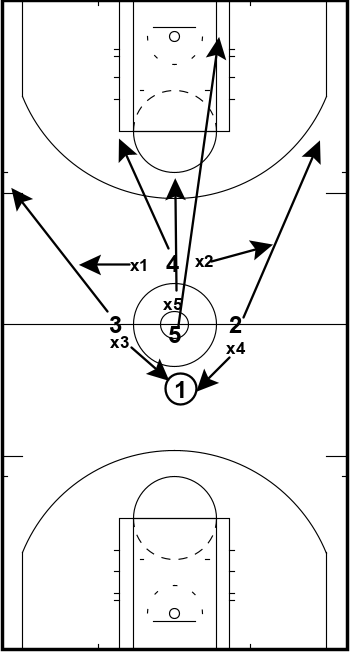
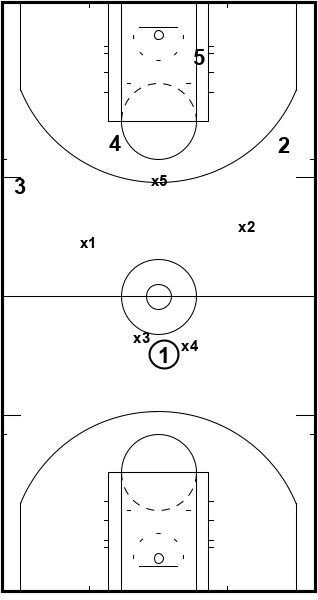
4 - Junk up your Opponent's End of Game Plays with this Hybrid Triangle & 2
One of the most frustrating parts of coaching is when your players do what they are supposed to do and a great player makes a play to beat you.
I remember as a kid watching an interview with former Knicks player Xavier McDaniel. In the video, he talks about guarding Larry Bird on the last possession of the game.
"It was a tied game. They had the ball. DJ was stalling the basketball, and Larry was kinda standing. I was behind him, denying him the ball. They called a time-out. He turned around and looked at me and said: 'Imma score right here on you.' I said: 'I know you will. I'll be ready! He shot a turnaround jump-shot, I just looked back, and the ball just went in, hit all net. He said: 'Told you so!'...Larry Legend is at it again!"
Fortunately, most of us don't have to coach against Larry Bird. However, we all have to coach against good players. At the end of a close game, we know these players are going to get the ball and take the shot to win the game.
So, how do we prevent Larry Bird or Jimmy Chitwood from beating us?
Consider a junk defense.
The most common of these are a box and 1 and triangle and 2. The Raptors famously used a box and 1 with great success against Steph Curry in the 2019 NBA Finals. An example of a box and 1 is shown below.

If a junk defense can work at the highest level of basketball, it can definitely work at the high school level.
As most have some familiarity with a box & 1 and triangle & 2, I won't delve into those. What I will suggest is a tweak on the traditional triangle & 2 you might find successful in stopping a star player in crunch time.
Hybrid Triangle and 2 - Double Team Best Player
If you are playing a team with one outstanding player, consider a triangle and 2 where both players who are in man to man are guarding the same player - the other team's star.
This results in them being double-teamed, which should prevent them from getting the ball. It will also take your opponent out of the play they called.
If you try this strategy, you don't even have to put your best defenders in the double team. Two average defenders should be able to prevent one player from catching the ball and creating space to score.
Instead, consider putting three of your best defenders in the triangle. They are responsible for covering 4 (albeit lesser players) so you'll want players who are quick and instinctive.
This defense does run the risk of giving up an open shot (but really, what defense doesn't?). However, the upside is the confusion it creates for the offense and the pressure it puts on weaker players to make plays.
5 - Giving a Foul
For years the debate has raged. If you're up 3 in the final seconds of the game, should you foul? I won't rehash the arguments, as you're probably familiar.
Ultimately, you must go with what you believe. However, if you do decide to foul, you must practice this.While it seems like this should be easy (we've all coached players who seem really gifted at fouling!), it isn't.
Two years ago, I was fortunate to coach an excellent team and one of the best players in our area. We were up 3 with :08 left in the game. The other team had the ball going full court. In the huddle, we decided to foul on the offense's second dribble.
Our opponent inbounded to a player being guarded by our best player (mentioned above). They dribbled two times, and... nothing happened. Our best and smartest player completely forgot to foul! Fortunately for us, they missed the shot and we won the game. However, by not practicing this scenario, I put our team in a position to fail.
As a result, we now practice fouling. You should too. In doing so, instruct your players to go aggressively for the steal.
We know that refs sometimes swallow their whistle at the end of close games. By going for the steal, you might get the ball back without a foul being called. This also eliminates the likelihood of an intentional foul being called as your player is making a play on the ball.
End of Quarter Fouling Consideration due to Elimination of 1 & 1s
Before we conclude, let me throw out one other defensive special situation related to fouling. The new NFHS rules eliminating the 1 & 1 and resetting fouls each quarter offer coaches the option to give fouls at the end of the first and third quarter if they aren't in the bonus.
Imagine your opponent has the ball with :30 left in the quarter. They are holding the ball for a last shot. You have only two team fouls (the bonus doesn't kick in until the fifth foul). With about :12 left in the quarter, they will run their play.
This situation allows you to commit two fouls in the last :10-:12 seconds of the quarter to prevent them from running the play they want to run. This can ultimately force them into a lower percentage shot at the end of the quarter.
If you implement this strategy, you may want to sub so that your best players aren't the ones giving the fouls.
Finally, if you're really bold and playing against a team with a bad free throw shooter, you might consider putting that poor shooter on the line at the end of the quarter to get the ball back.
Let's say your opponent has a player who shoots 40% on free throws. If you foul that player in the last minute of the quarter, those two shots will generate 0.8 points for your opponent. You will then get the ball back with an opportunity to score at the end of the quarter.
Florida coach Todd Golden used this strategy a couple of years ago at San Francisco. You can read more about that here.
Final Thoughts
Special situations are a critical part of basketball. And yes, the defensive side of special situations is often neglected.
Use this to your advantage. By preparing your team for defensive special situations, you will have a leg up on the competition.
If the strategies above result in even one more win this year, would that be worth 20 minutes a week of your playing time? I know that's a trade I would gladly make. Work some of these wrinkles in and turn games in your favor!
What do you think? Let us know by leaving your comments, suggestions, and questions...
|
|||||



 Facebook (76k Likes)
Facebook (76k Likes) YouTube (85k Subscribers)
YouTube (85k Subscribers) Twitter (26k Followers)
Twitter (26k Followers) Q&A Forum
Q&A Forum Podcasts
Podcasts